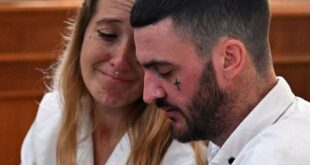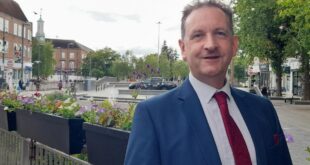Anna O’Sullivan’s life was the story of modern Ireland. She was born on November 1st, 1920 – the same day that the 18-year-old Kevin Barry was executed at Mountjoy prison in Dublin – and grew up in Co Cavan against a background of extraordinary upheaval: the War of Independence, Civil War, and the first tentative steps of the independent State. She was one of 11 children raised in the O’Reilly family home in Lavey, a townland not far from where the Border would be drawn while she was still a baby.
Poor economic prospects at home in the early years of the Free State, coupled with labour shortages in Britain, caused a wave of emigration across the Irish Sea in the 1930s. Thousands of single women made the journey, and Anna O’Sullivan was one of them.
At the age of 19 she went to Liverpool to train as a nurse, then moved to London, where she worked at the North Middlesex Hospital. She was there through the second World War. Anna would later tell her children how, during the Blitz, she would lie in bed at night, listening to the bombs fall from the sky. One night there was a direct hit on the children’s ward at the hospital. But she didn’t say much about that time; she wasn’t keen on talking about her war years.
Anna returned to Ireland after the war and worked first at Cavan hospital and then at Loughlinstown in Dublin. It was there she met Michael O’Sullivan, an Irish speaker from Co Kerry. They settled in Tralee.
Anna’s family described her as a loving woman, resilient and practical. She knew great joy, but also grief and pain. She and Michael first had twins, Josephine and Maria, but Maria died after just a few days. Then came Jacqueline and their youngest, Philomena, who had cerebral palsy and died at the age of 10.
When Michael retired in 1978 they moved to Leixlip, Co Kildare, to spend their retirement near their daughters, but Michael died just two years later. Anna moved in with Jacqueline and her family, and helped raise her daughter’s three children.
She rarely complained, her grand-daughter Fiona would say at Anna’s funeral. She got on with things. She was an avid walker, and a woman of deep faith; she said the rosary every night, praying for each of her children and grandchildren. Illnesses came and went – she survived breast cancer, and surgery following a bad fall that caused a bleed on her brain. Each time she battled through.
Then, in May this year, Anna fell ill and was brought to Connolly hospital in Blanchardstown, Dublin, where she tested positive for Covid-19. She died six days later, just a few months shy of her 100th birthday.
Anna O’Sullivan was the oldest person to be profiled in Lives Lost, an Irish Times project that memorialised those lost to coronavirus, in Ireland and among the diaspora, in 2020. (The youngest, Dubliner Christopher “Kicky” McCormack, was 32). But her story is typical in many respects. The virus has been deadliest for those already least equipped to resist it; in the Republic, the median age of those who have died is 83.
Behind each of those deaths, solemnly announced on the evening news almost every day since mid-March, was a family’s heartbreak at the loss of a loved one. But together, as those deaths accumulated, they also told a story of a generation that lived through the defining moments of the past century and, in their individual ways, helped to transform the country.
Typically, newspaper obituaries are reserved for the powerful, rich and famous – the unrepresentative few. These ones were of ordinary lives – the everyday, the unsung, the largely unknown – yet their insights, it turned out, were more revealing for that.
Those profiled in Lives Lost belonged a generation whose fortunes reflected those of the young state in which they came of age – its failures, its successes, its cruelties and its possibilities. They were born into a country still finding its way, where the Catholic Church was all-powerful and extreme poverty was endemic.
When she first moved to Dublin, Delia Kennedy, born in Co Tipperary in 1925, said she was shocked by the scenes she encountered: people walking barefoot on Gardiner Street, or sitting outside tenements playing cards because they had nothing else to do. They were, as one bereaved relative said, “the generation that had nothing”.
Many of them chose to leave, or felt they had no choice but to go. They hit adulthood in the 1950s, the “lost decade” in which about 16 per cent of the population are thought to have emigrated. In Britain and the US, they plugged into Irish diaspora networks and, in nearly all cases profiled, they married other Irish emigrants. Some thrived, setting up businesses or becoming pillars of their adopted communities.

Joseph Swaine from Co Wicklow, who emigrated at 19, would run pubs and off-licences in England. Patrick Brady, the son of a farm-keeper from Co Kildare, followed the same path in 1952, aged 17, and worked for the Royal Mail all his life. He won a medal for bravery after foiling an attempted robbery.
Others struggled far from home. Rita Whelan, from Cornamona in west Galway, raised three children in London while her husband Tom worked on building sites, but she suffered from mental health problems and was later admitted to care.
Those who left found work, but it was often tough, physical labour that took a heavy toll. The family of Martin McNamara from near Gort, Co Galway, who worked as a labourer and plasterer in Cricklewood from the age of 15 or 16, recalled the ritual of their father arriving home after a week’s work and falling asleep straight away. McNamara and his wife, Joanne, eventually returned to Ireland, as did many others.

Berna Lee went to live with her aunt in Brooklyn when she was 17. She spent 50 years there, married and raised children before making the return trip home to Clane, Co Kildare, where she had a long and active retirement.

Ill-health is a recurring theme. In late 1930s Ireland, when those at the median age of 83 were born, life expectancy was below 60 and infant mortality was high. Kathleen Marry, a dressmaker’s apprentice from Swords, spent 18 months in a tuberculosis sanatorium while her husband-to-be, Frankie, wrote letters and paid her weekly visits.
When a parent died, it would usually alter the course of a child’s life. At the age of 15, David Griffin from Drimnagh left school and became his family’s main breadwinner after his father died.

Similarly, Bernard Tormey from Seville Place in Dublin left school at 14 when his own father died. He followed his older brother into the Dublin railways, where he would work for 40 years. Bernard never travelled, except through his beloved books about the US, its history and music. Nor did he marry; later in life, he would tell his niece Natalie about a woman he loved during his youth. “I remember him saying, ‘Some day I’ll tell you, she was the love of my life.’ He never did.
In an era when few travelled afar for leisure, the world still had a way of making itself felt. When James Cleary and four friends cycled to Rome in 1950, taking up Pope Pius XII’s invitation to Catholics to come and celebrate a Holy Year, they crossed a continent still scarred by war, on one occasion having to cycle for miles to find a river crossing because the bridge they planned to cross had not yet been rebuilt.

When Cyril Fitzsimons emigrated to America in 1964, he joined the US marines and soon found himself fighting in the Vietnam war.

Culturally, change was in the air. Mary O’Connell, a gifted artist from Omagh, Co Tyrone, once met Pablo Picasso in the south of France (she found him grumpy).
As a young emigrant in London, Maisie Byrne from Co Carlow was a face in the crowd at an early Beatles gig.
The Ireland these people were born into was no country for young women. Entry after entry tells of women who were forced to give up jobs they loved due to the marriage bar. Many of them pushed back against the social strictures of the time.
Esther Jennings, raised in Donnycarney in Dublin, went to school at Kings Inn Street Sisters of Charity primary school, where she was taught by Margaret Skinnider, who had fought in the 1916 Rising. The feminist Skinnider had a big influence on Esther, and encouraged her to continue her education. Esther ended up having to work to help her family of 12, but she found it liberating to be out in the world and financially independent.
Afraid that she would have to give up her job, she used to insist she would never marry, though after resisting at first she eventually gave in to Paddy Jennings’s charms and married him in 1950.
Brigid Sreenan from Co Longford would have liked to stay on the family farm – her family said she was never happier than when she was helping her father on the bog as a child – but her brothers inherited everything, and she always resented it. Brigid left school at 12 and was sent to work (for no pay) with an aunt in a hotel in Moate, Co Westmeath.
More unusual was the experience of Teresa Kelly, who, as an only child, inherited the family farm in Co Cavan.

In several of the life stories are hints of torment and pain – alcoholism, sexual abuse, parental neglect – that went largely unspoken, and which some of those featured took to their graves.
Running through many of these stories is a keen sense of regret over the cutting short of education and the opportunities that closed off as a result. “Mammy placed great store in education and wanted to ensure that her children could avail of the educational opportunities that were denied her in 1940s Ireland,” her son Paddy said of Bridie Connaughton, the second eldest of eight children from Co Mayo.

At the same time their life stories also pulse with the opposite of regret: a sense of satisfaction and fulfilment. Often the source was friends and family, a rich later life surrounded by grandchildren or filled with things that were once beyond reach, such as frequent travel or long, lazy days in the garden. For others it was the feeling of belonging they took from their community. They coached GAA teams, ran charity shops, volunteered at the local resource centre or got involved in local activism, showcasing the quiet virtues of sincerity, resilience and decency.
Covid-19 public health restrictions meant many families were denied the chance to say goodbye to a loved one, or to grieve as they would have wished. Some spoke their final words by video-call, or through a nursing home window. With restrictions on funeral attendance, communities found new ways to pay respect, often emerging on to the streets to form a guard of honour for a departing neighbour.
That was what they did on Auburn Drive in Castleknock, Dublin, where Sadie Kennedy Power, a retired nurse and returned emigrant, had settled in her later years and where, she often remarked, she had found the kindest people she ever met. The country was in lockdown; the streets were quiet on that cool, sunny morning in April. As the funeral cortege passed by the house, more than 60 neighbours lined the footpath. “Be not afraid,” they sang.
Source link



